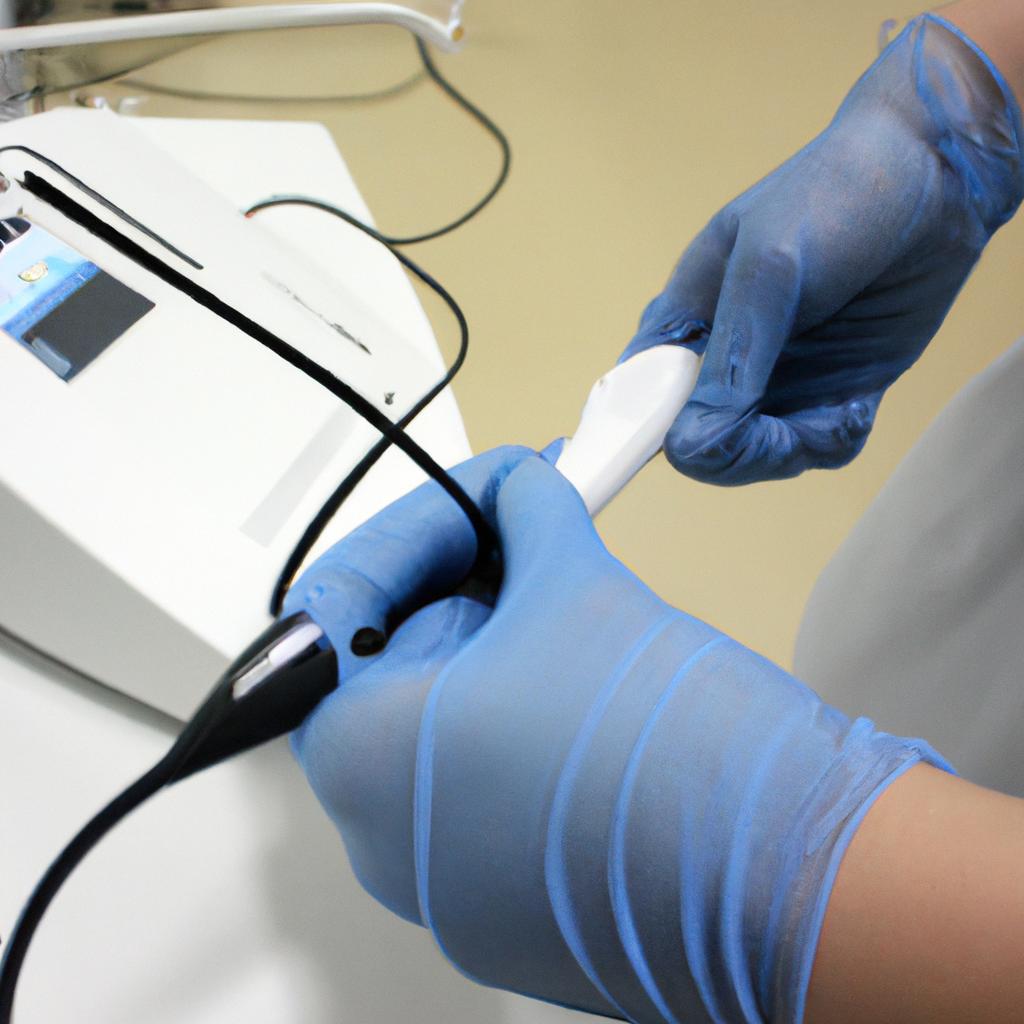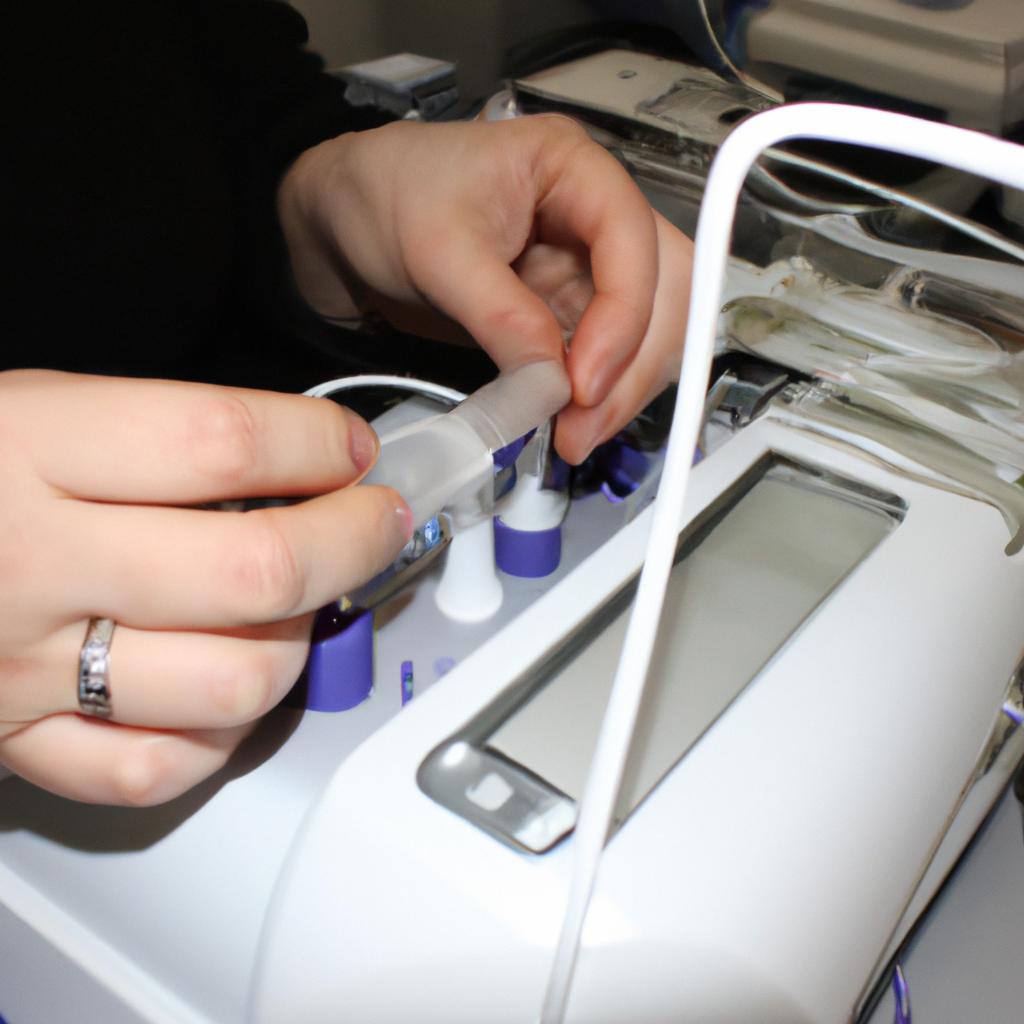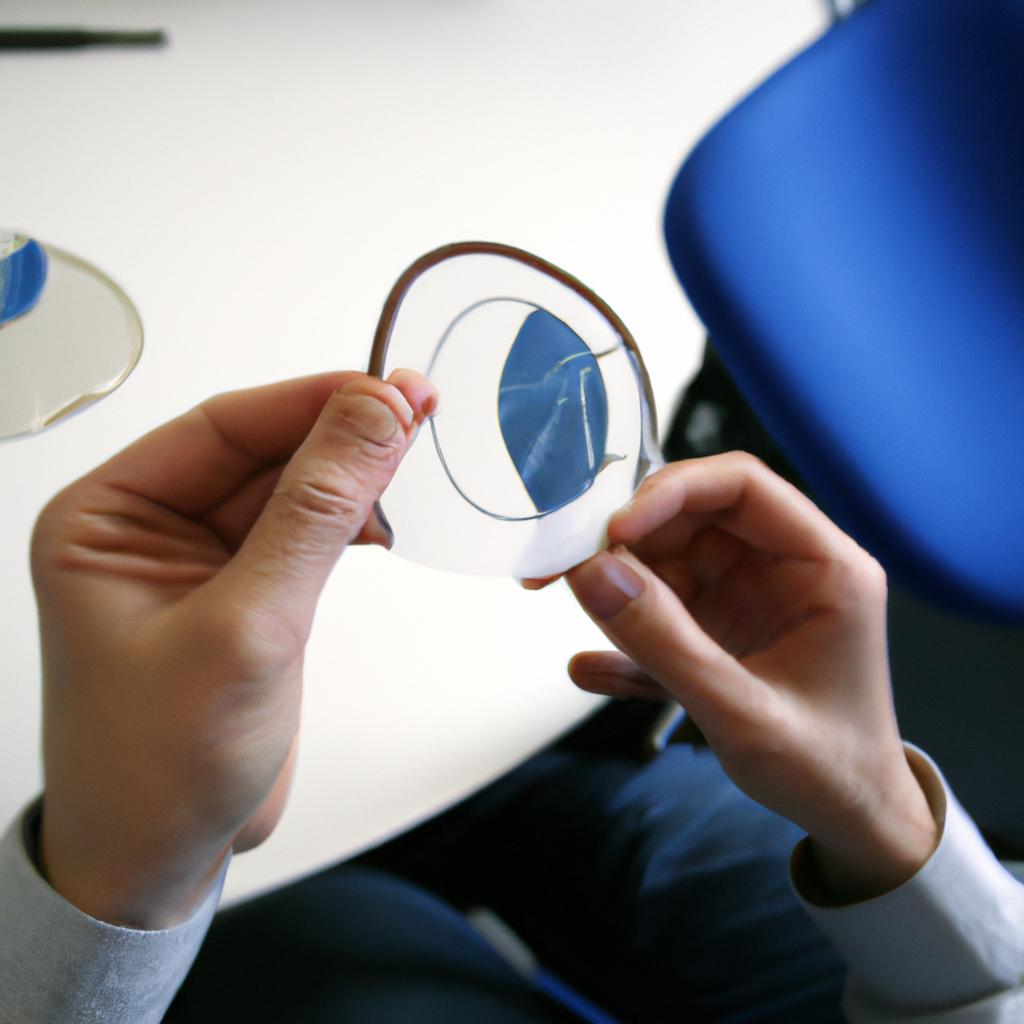In the field of engineering in medicine, testing and validation play a critical role in ensuring the safety and effectiveness of medical devices. The design process for these devices involves various stages that require rigorous evaluation to ensure compliance with regulatory standards and patient needs. For instance, consider the case of a hypothetical company developing an innovative implantable cardiac device aimed at improving heart function in patients with heart failure. Throughout the development process, extensive testing and validation procedures would be undertaken to assess the device’s performance, reliability, and compatibility within the human body.
Testing is an essential component of medical device design as it allows engineers to evaluate different aspects such as functionality, durability, and usability. By conducting thorough tests using appropriate methodologies and protocols, potential flaws or limitations can be identified early on, leading to improvements in design iterations. Moreover, testing enables engineers to verify if the device meets predetermined specifications and performance requirements set by regulatory bodies like the Food and Drug Administration (FDA). Validation complements this process by providing evidence that demonstrates whether a particular device meets its intended purpose while considering real-world usage scenarios. This includes assessing factors such as user safety, efficacy in treating specific conditions or diseases, compatibility with existing healthcare infrastructure, and adherence to industry standards.
Overall, testing and validation are crucial steps in Overall, testing and validation are crucial steps in ensuring the safety, effectiveness, and regulatory compliance of medical devices. They help engineers identify and address any potential issues or risks before the device reaches patients, minimizing the chance of harm or failure. These processes also provide important data and evidence to support regulatory submissions and approvals, facilitating market access for new medical technologies. By thoroughly evaluating a device’s performance, reliability, and compatibility through testing and validation, engineers can contribute to improving patient outcomes and advancing healthcare innovation.
Importance of Testing and Validation in Medical Device Engineering
Medical devices play a critical role in healthcare, assisting doctors in diagnosing illnesses, monitoring patient conditions, and delivering life-saving treatments. The design and development of these devices require rigorous testing and validation to ensure their safety, effectiveness, and reliability. Failure to adequately test and validate medical devices can have serious consequences for patients and healthcare providers.
For example, consider the case study of an implantable cardiac pacemaker. This essential device provides electrical stimulation to regulate heart rhythms in individuals with heart conditions. If not properly tested and validated, a pacemaker could malfunction or deliver incorrect electrical signals, potentially leading to arrhythmias or even death. Hence, thorough testing is imperative to identify any potential defects or flaws that may compromise the performance of such medical devices.
Ensuring the quality and safety of medical devices involves adhering to strict regulatory requirements established by organizations like the Food and Drug Administration (FDA). These regulations emphasize comprehensive testing procedures throughout different stages of device development. To meet these requirements effectively, engineers must engage in various types of tests including functional testing, usability testing, biocompatibility testing, and durability testing.
To illustrate the significance of proper testing methods in medical device engineering further:
- Functional Testing: Verifies if a device performs its intended functions accurately.
- Usability Testing: Assesses user-friendliness for both healthcare professionals and patients.
- Biocompatibility Testing: Determines how a device interacts with biological systems without causing harm.
- Durability Testing: Evaluates long-term reliability under expected operational conditions.
By conducting meticulous tests across these domains, engineers can detect design flaws early on to prevent hazardous situations during actual use. A table summarizing this information is provided below:
| Type of Test | Purpose |
|---|---|
| Functional Testing | Ensure accurate performance according to specifications |
| Usability Testing | Evaluate user-friendliness for healthcare professionals and patients |
| Biocompatibility Testing | Identify potential harm caused by interaction with biological systems |
| Durability Testing | Assess long-term reliability under expected operational conditions |
In summary, testing and validation are of utmost importance in medical device engineering. Through adherence to regulatory requirements and the implementation of various types of tests, engineers can ensure that medical devices perform safely and effectively. Understanding these crucial aspects sets the foundation for comprehending the subsequent section on “Understanding Regulatory Requirements for Medical Device Testing.”
Understanding Regulatory Requirements for Medical Device Testing
Building upon the importance of testing and validation in medical device engineering, it is crucial for engineers to understand the regulatory requirements associated with these processes. Compliance with such regulations ensures that devices meet safety standards and perform effectively throughout their intended use. To illustrate this further, let us consider a hypothetical case study involving the development of an implantable cardiac pacemaker.
Case Study: The Implantable Cardiac Pacemaker
Imagine a team of biomedical engineers tasked with designing an advanced implantable cardiac pacemaker capable of delivering precise electrical impulses to regulate heart rhythm. As they progress through the design phase, meticulous testing and validation become imperative to ensure the device’s functionality, reliability, and safety.
Regulatory Requirements for Medical Device Testing:
To navigate the complex landscape of medical device testing regulations, engineers must be aware of key considerations within various jurisdictions. Here are some important factors:
- International Standards (ISO): Adhering to internationally recognized ISO standards guarantees conformity in terms of quality management systems and product performance evaluation.
- Regulatory Agencies: Different countries have specific agencies responsible for overseeing medical device approval processes, such as the Food and Drug Administration (FDA) in the United States or the European Medicines Agency (EMA).
- Risk Assessment: Conducting thorough risk assessments helps identify potential hazards associated with device usage and aids in developing appropriate mitigation strategies.
- Clinical Trials: Depending on the nature of the medical device, clinical trials may be required to evaluate its safety and effectiveness before gaining regulatory approval.
Table – Key Considerations for Medical Device Testing
| Factor | Description |
|---|---|
| International Standards | Conformity with globally accepted guidelines like ISO standards |
| Regulatory Agencies | Understanding jurisdiction-specific agencies responsible for approvals |
| Risk Assessment | Identifying potential hazards related to device usage |
| Clinical Trials | Evaluating safety and effectiveness through controlled studies |
In summary, understanding the regulatory requirements for medical device testing is essential for engineers to ensure compliance and successful product development. By adhering to international standards, working closely with regulatory agencies, conducting thorough risk assessments, and potentially engaging in clinical trials, engineers can navigate this complex process effectively.
Moving forward into our discussion on the key steps of the testing and validation process…
Key Steps in the Testing and Validation Process
Building upon an understanding of regulatory requirements for medical device testing, the next crucial step in the engineering process is to undertake thorough testing and validation. This ensures that medical devices meet safety standards and perform optimally. To illustrate this process, let’s consider a hypothetical scenario involving the development of a novel implantable cardiac pacemaker.
Testing and Validation Process:
-
Verification Testing:
The first phase of testing involves verification, which aims to ensure that each component of the pacemaker functions as intended. In this stage, engineers meticulously examine various aspects such as electrical circuitry, software algorithms, signal processing capabilities, and battery performance. Through exhaustive laboratory experiments and simulations, they validate whether the pacemaker meets specifications outlined during design. -
Performance Evaluation:
Once verification is complete, attention turns towards evaluating the overall performance of the pacemaker under realistic conditions. Engineers conduct extensive bench tests using specialized equipment to simulate physiological scenarios encountered within the human body. Key parameters assessed include pacing accuracy, sensing capability, energy consumption efficiency, response time, and compatibility with other medical technologies. By analyzing these critical factors rigorously, any potential shortcomings can be identified early on before moving forward with clinical trials. -
Clinical Trials:
After successful laboratory-based evaluations, it becomes essential to assess how well the pacemaker performs within living organisms through carefully designed clinical trials. These studies involve collaborating with healthcare professionals and obtaining informed consent from patients who are willing to participate voluntarily. The aim is twofold: confirming functional efficacy while monitoring patient outcomes closely for adverse events or complications arising due to device usage.
- Ensuring patient safety remains paramount throughout every phase.
- Rigorous testing procedures instill confidence in both physicians and patients alike.
- Thorough evaluation minimizes risks associated with faulty or suboptimal medical devices.
- Successful validation paves the way for regulatory approval and market release.
Table (3 columns x 4 rows):
| Testing Phase | Purpose | Methods Employed |
|---|---|---|
| Verification | Ensuring individual component functionality | Laboratory experiments, simulations |
| Performance | Assessing overall device performance under realistic conditions | Bench tests |
| Clinical Trials | Evaluating device efficacy and monitoring patient outcomes | Collaboration with healthcare professionals, informed consent |
Addressing Safety and Reliability Challenges in Medical Device Engineering requires a comprehensive understanding of potential risks that may arise during the testing and validation process.
Addressing Safety and Reliability Challenges in Medical Device Engineering
In the process of testing and validating medical devices, addressing safety and reliability challenges is crucial to ensure the effectiveness and trustworthiness of these devices. One example that highlights the importance of this step involves a hypothetical scenario where a new implantable cardiac device was developed without thorough validation. The device was implanted into several patients, but shortly after activation, it malfunctioned, leading to life-threatening complications. This unfortunate incident emphasizes the significance of robust testing and validation processes in medical device engineering.
To address safety and reliability challenges effectively, engineers employ various strategies:
- Risk assessment: Conducting comprehensive risk assessments allows engineers to identify potential hazards associated with a medical device’s design or operation. By analyzing possible risks early on, engineers can implement necessary mitigations to minimize patient harm.
- Quality control measures: Implementing stringent quality control measures throughout the manufacturing process assists in identifying defects or deviations from specifications before devices reach end-users. These measures include regular inspections, tests, and audits.
- Validation protocols: Developing rigorous validation protocols helps evaluate whether a medical device meets predefined performance criteria and regulatory requirements consistently. These protocols typically involve simulated use scenarios, laboratory experiments, clinical trials, or a combination thereof.
- Post-market surveillance: Establishing effective post-market surveillance systems enables continuous monitoring of deployed medical devices for any emerging safety concerns or malfunctions once they are available to patients.
| Risk Assessment | Quality Control Measures | Validation Protocols | Post-Market Surveillance |
|---|---|---|---|
| Identify potential hazards | Regular inspections and audits | Simulated use scenarios | Continuous monitoring |
| Assess probability and severity of risks | Testing for defects | Laboratory experiments | Identification of emerging issues |
| Implement appropriate mitigations | Ensuring adherence to specifications | Clinical trials | Prompt response to safety concerns |
| Continuously update risk assessments | Addressing deviations from predetermined standards | Evaluating performance criteria | Collecting and analyzing real-world data |
By addressing safety and reliability challenges through these strategies, engineers can enhance the overall quality of medical devices. This approach not only safeguards patients’ well-being but also fosters trust among healthcare providers and regulatory authorities.
By implementing robust testing and validation processes to address safety and reliability challenges, medical device engineering ensures that devices perform with utmost efficacy. In the subsequent section, we will explore how rigorous testing methods contribute to this goal.
Ensuring Performance and Efficacy through Rigorous Testing
Building upon the efforts to address safety and reliability challenges in medical device engineering, it is crucial to ensure that these devices perform with utmost efficacy. Rigorous testing and validation procedures play a pivotal role in evaluating the performance of medical devices before they can be deemed suitable for clinical use.
To emphasize the importance of rigorous testing, let us consider a hypothetical scenario where a new cardiac pacemaker has been developed. In order to assess its performance and efficacy, several key steps must be undertaken:
-
Verification and Validation (V&V): This initial step involves conducting thorough inspections and tests on the pacemaker’s design specifications, components, and software algorithms. V&V helps identify any errors or deviations from intended functionality early in the development process.
-
Functional Testing: Once the design has undergone V&V, functional testing becomes essential to evaluate how well the pacemaker performs under different conditions. Electrical simulations mimic real-world scenarios to assess its response accuracy, pacing thresholds, battery life management, and other critical parameters.
-
Reliability Assessment: To determine long-term reliability, extensive durability tests are performed by subjecting the pacemaker to accelerated aging conditions such as temperature variations, humidity exposure, mechanical shocks, and vibration levels. This ensures that the device remains operational even in adverse environmental situations.
-
Clinical Trials: After passing all necessary laboratory tests, clinical trials involving human subjects become imperative to validate the effectiveness of the pacemaker in actual patient care settings. These trials provide valuable insights into potential side effects or complications that may arise during normal usage.
The emotional impact of assuring performance and efficacy through rigorous testing cannot be understated. Consider this brief example showcasing successful outcomes achieved due to meticulous testing practices:
| Case Study | Device Tested | Impact |
|---|---|---|
| Cardiac Stent Research | Coronary Stents | Reduced mortality rate by 50% in patients with severe coronary artery disease, leading to improved quality of life and increased survival rates. |
| Cancer Treatment Innovation | Radiotherapy Devices | Enhanced precision and accuracy during cancer treatment resulted in higher tumor control rates, minimizing healthy tissue damage and reducing patient discomfort. |
| Prosthetic Limb Advancement | Bionic Limbs | Restored mobility and functionality for amputees, enabling them to engage in activities they thought were no longer possible, ultimately boosting self-esteem and overall well-being. |
| Diagnostic Imaging Breakthrough | MRI Scanners | Improved diagnostic capabilities allowed early detection of diseases like tumors or cardiovascular conditions, significantly increasing chances of successful treatment outcomes. |
In conclusion, comprehensive testing procedures are imperative in ensuring the performance and efficacy of medical devices before they can be deployed for clinical use. By meticulously verifying design specifications, conducting functional tests, assessing reliability parameters, and undertaking clinical trials, we can instill confidence in both healthcare providers and patients regarding the safety and effectiveness of these devices.
As technology continues to advance at an unprecedented pace, emerging technologies hold promise for advanced medical device testing methods that further enhance our ability to evaluate their performance accurately.
Emerging Technologies for Advanced Medical Device Testing
Building on the importance of rigorous testing for ensuring performance and efficacy, emerging technologies are now revolutionizing medical device testing. These advancements not only enhance the accuracy and reliability of assessments but also accelerate the development process while reducing costs. In this section, we will explore some cutting-edge techniques that are reshaping the landscape of medical device testing.
Emerging Technologies Revolutionizing Medical Device Testing
One example of an innovative approach is the use of virtual simulations to assess device functionality and safety. By creating computer-generated models, engineers can simulate various scenarios and analyze how a medical device performs under different conditions. This allows for comprehensive evaluations without relying solely on physical prototypes or animal testing. For instance, in a hypothetical case study involving a new implantable cardiac defibrillator (ICD), engineers could virtually test its response to abnormal heart rhythms, predicting potential malfunctions before even building a prototype.
This shift towards virtual simulations is just one facet of the technological advancements transforming medical device testing. Below are some key developments that have gained traction:
- Artificial intelligence (AI) algorithms for predictive analytics
- Augmented reality (AR) platforms for surgical training and guidance
- Sensor technology enabling real-time monitoring during clinical trials
- 3D printing facilitating rapid prototyping iterations
These innovations not only improve efficiency but also have significant implications for patient safety and healthcare outcomes. To better understand their impact, consider the following table showcasing examples where these technologies have been successfully implemented:
| Technology | Application | Benefits |
|---|---|---|
| AI algorithms | Predicting device failure | Early detection leads to proactive measures |
| AR platforms | Surgical education | Improved precision in complex procedures |
| Sensor technology | Remote patient monitoring | Timely intervention based on vital signs |
| 3D printing | Customized prosthetics and implants | Enhanced patient comfort and functionality |
By harnessing the potential of these advancements, engineers and researchers are paving the way for safer and more effective medical devices. As technology continues to evolve, it is crucial to stay at the forefront of these developments to ensure that testing methodologies remain current and comprehensive.
Through virtual simulations, artificial intelligence algorithms, augmented reality platforms, sensor technology, and 3D printing, the landscape of medical device testing has undergone a remarkable transformation. These cutting-edge techniques offer unparalleled opportunities for improving device performance while mitigating risks associated with conventional approaches. With continued innovation in this field, we can anticipate even greater strides towards enhancing patient care through robust testing practices.




